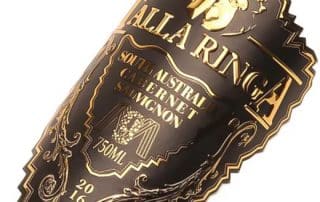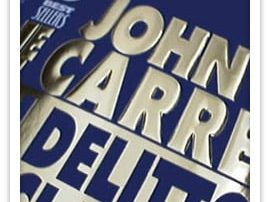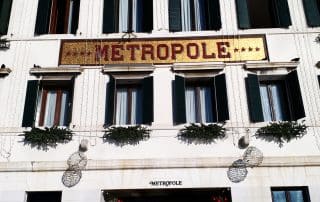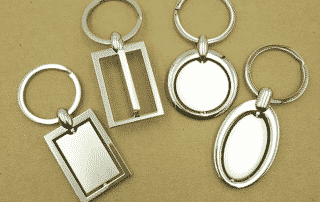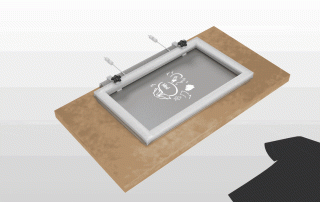Creating eye-catching, custom promotional items is an art, and printing techniques are the paintbrush. In this modern era, we have a plethora of options that allow businesses to leave a unique and lasting impression.
But, how do we achieve that perfect, vibrant logo on a challenging surface like metal? This is a question that often arises. In this article, we delve into the innovative methods that enable us to print high-resolution logos on metal, transforming the ordinary into something truly extraordinary.

Why Print Logos on Metal Products?
Choosing to print logos on metal products is a strategic move that extends beyond just looks. The robustness of metals such as aluminum and stainless steel guarantees that logos stay clear and readable over time, even in tough conditions. This enduring nature is vital for preserving brand visibility and credibility, making metal a perfect choice for items that see a lot of use.
Moreover, metals have a sleek, modern charm that boosts the perceived worth of the product. This up-to-date look can lift the brand’s image, associating it with elegance and quality. The visual advantages of metal lead to a more refined and polished look, which can draw in discerning customers.

The resilience of metals against wear and tear means that branding efforts are not easily compromised. This provides a reliable medium for long-term brand recognition. As businesses seek to create lasting impressions, printing logos on metal products underscores the importance of combining durability and aesthetics in effective branding strategies.
Here are some benefits:
- Metal withstands time and elements, ensuring your logo lasts.
- Metal’s sleek look and color vibrancy enhance logo aesthetics.
- Logos on metal products boost brand awareness effectively.
- Metal can be molded into various shapes, offering design flexibility.
- Many metals are recyclable, supporting eco-conscious branding.
This approach protects the brand’s visual identity and reinforces its commitment to quality and excellence. By choosing metal, brands can ensure their logos withstand the test of time while making a strong, positive impression on their audience.
Key Factors for High-Resolution Printing
Achieving high-resolution prints on metal involves several key factors, each contributing to the final quality and durability of the print.
Here are some key factors to keep in mind:
- Printing Methods: There are a variety of methods used for printing on metal, each with its own set of benefits and considerations.
- Materials: Metal photo prints typically use aluminum as the base material. This metal is chosen for its durability, lightweight nature, affordability, and suitability for printing compared to many other options.
- Printing Technique: The technique used for printing on metal can significantly influence the final outcome.
- Surface Preparation: Prior to printing, the metal surface must be clean and free from contaminants. Some printers also use Dibond aluminum sheets, which consist of a front and back made of aluminum that encases a plastic core.
- Ink Quality: The quality of the ink used for printing can greatly affect the clarity and vibrancy of the final print. High-quality inks designed for photo printing often deliver finer droplets and more precise placement, resulting in clearer, sharper images.
Remember, achieving high-resolution prints on metal is a complex process that requires careful consideration of all these factors. It’s always best to work with a professional printing service to ensure the best results.
Understanding Metal Types

Different metals react differently to various printing techniques. Common metals for custom logo designs include aluminum, stainless steel, brass, and copper.
Each metal has its unique properties and uses:
- Aluminum: Lightweight and resistant to corrosion.
- Stainless Steel: Durable and has a professional finish.
- Brass: Offers a classic, antique look.
- Copper: Provides a rustic and artistic appeal.
Choosing the right metal for your project is the first step to ensuring a successful print.
Metal Printing Methods
Laser Engraving

Laser engraving is a technique that’s popular for its precision and durability, especially when it comes to imprinting high-definition logos on metal surfaces.
It works by using a laser beam to carve the design straight onto the metal, creating a lasting and detailed impression.
What sets this method apart is its knack for capturing the most intricate details and complex designs, making it the go-to choice for top-notch logo printing on a range of metal items.
Process:
- A digital design fed into a computer-controlled laser engraving machine.
- The focused laser beam is directed onto the metal surface.
- The intense heat generated by the laser vaporizes or removes the material, carving out the design.
- The depth and intensity of the engraving can be fine-tuned.
- After the engraving process, the metal surface may be cleaned to remove any residue, ensuring a clear and sharp design.
Advantages:
- Ideal for intricate and complex logos.
- Permanent engravings resistant to wear, fading, and corrosion.
- Suitable for various metals such as stainless steel, aluminum, and titanium.
Applications:
Laser engraving is commonly employed for branding and logo printing on metal products such as promotional items, industrial equipment, jewelry, and personalized gifts. This method is also often used to create serial numbers, barcodes, and other identification marks on metal components, ensuring traceability and authenticity.
Sublimation Printing

Sublimation printing is a popular technique known for its vibrant colors and lasting results, especially when it comes to imprinting high-quality images on various surfaces. This method works by transferring dye onto materials using heat, resulting in a seamless and durable design. What sets sublimation printing apart is its ability to produce vivid and detailed images, making it the go-to choice for high-quality photo printing and custom merchandise.
Process:
- The process begins with creating a digital design, which is then printed onto a special transfer paper using sublimation ink.
- The printed transfer paper is placed on the desired material, such as fabric, ceramic, or metal.
- Using a heat press, the material and transfer paper are subjected to high temperatures (typically between 350°F to 400°F).
- Under the heat and pressure, the sublimation ink turns into a gas without passing through a liquid state and permeates the material.
- As the material cools, the dye solidifies, becoming a permanent part of the surface.
Advantages:
- Produces bright and vivid colors that are resistant to fading.
- Captures intricate details and high-resolution images with ease.
- The design becomes part of the material, making it resistant to peeling or cracking.
- Suitable for a wide range of materials.
Applications:
Sublimation printing is commonly used for creating custom apparel, such as T-shirts and sportswear, where vibrant and durable prints are desired. It is also popular for producing personalized items like mugs, phone cases, and mouse pads. Additionally, it is often employed for printing promotional products, signage, and photo gifts, ensuring high-quality and lasting impressions.
UV Printing

UV printing uses ultraviolet light to cure or dry the ink as it is printed, making it an excellent method for creating high-resolution images on various surfaces, including metal. The process ensures fast curing times and vibrant, detailed prints, making it ideal for both commercial and artistic applications.
Process:
- A digital design is sent to a UV printer.
- The printer applies specially formulated UV ink onto the surface.
- As the ink is applied, ultraviolet lights immediately follow to cure or dry the ink.
- Multiple layers of ink can be applied and cured successively for added depth and texture.
Advantages:
- Produces detailed and vibrant images with high color accuracy.
- UV-cured prints are resistant to fading, scratching, and chemical exposure.
- Suitable for a wide range of materials, including metals, plastics, glass, and ceramics.
- Rapid curing process allows for faster production times without the need for additional drying time.
Applications:
UV printing is widely used for creating custom signage, promotional items, and decorative pieces. It is ideal for printing on metal products such as plaques, awards, and industrial nameplates. Additionally, UV printing is popular in producing personalized gifts, packaging, and high-end marketing materials, where vibrant, durable, and high-resolution images are essential.
Electrolytic Etching

Electrolytic etching involves using an electric current to etch the design onto the metal, providing a precise and detailed method for creating intricate logos. This technique is valued for producing consistent and sharp etchings on various metal surfaces.
Process:
- A stencil or mask of the desired design is applied to the metal surface, exposing only the areas to be etched.
- The metal is immersed in an electrolyte solution, facilitating electric current flow.
- An electric current is applied, causing a controlled chemical reaction.
- The chemical reaction dissolves the exposed metal areas, etching the design into the surface.
- The etching process leaves behind a crisp and detailed etched design.
Advantages:
- Ideal for creating detailed and intricate logos.
- Provides uniform etchings with sharp edges.
- Suitable for various metals, including stainless steel, copper, and brass.
Applications:
Electrolytic etching is commonly used for branding and logo printing on metal products such as nameplates, signage, and decorative items. It also creates detailed circuit boards, identification tags, and art pieces. This method is particularly useful for applications requiring precise and consistent etchings, ensuring high-quality and professional results.
Step-by-Step Guide to Printing on Metal
Step 1: Selecting the Metal Surface
First, choose the type of metal that suits your project. Aluminum, stainless steel, brass, and copper are all good options, each with its own characteristics like weight, durability, and appearance. Pick one that meets your needs.
Step 2: Preparing the Metal Surface
Next, clean the metal surface thoroughly. Use a degreaser or mild detergent to remove any dust, grease, or residue, and rinse it with water. Make sure the surface is completely dry. For better print adhesion, you can lightly sand the metal.
Step 3: Choosing the Printing Method

Decide on the best printing method for your design and material. Popular choices include laser engraving, UV printing, sublimation printing, and electrolytic etching. Consider what each method offers in terms of detail, durability, and finish.
Step 4: Setting Up the Equipment
Set up your printing equipment according to the manufacturer’s instructions. Proper calibration is crucial for the best results:
- Laser Engraving: Adjust the laser’s power and speed settings.
- UV Printing: Load the UV ink cartridges and set up the printer.
- Sublimation Printing: Prepare the heat press and set the correct temperature.
- Electrolytic Etching: Assemble the electrical circuit and prepare the electrolyte solution.
Step 5: Executing the Print
Now, execute the print carefully, following the specific steps for your chosen method. Pay close attention to detail to ensure a high-quality finish.
Step 6: Post-Printing Finishing Touches
After printing, consider applying a protective coating to enhance durability and appearance. Clear coatings like varnish, lacquer, or epoxy can protect against wear and environmental damage. Finally, clean the metal again to remove any residue and inspect the final product to ensure it meets your quality standards.
What Can ODM Offer?
In the dynamic world of manufacturing, The ODM Group stands out with its consistent innovation in printing techniques. We collaborate with reliable manufacturers to ensure our clients receive top-notch products and services.
ODM can also help you produce other promotional merchandise ideas for your business. We can help you source promotional cutleries, custom beer flight sets, promotional drinking glasses, branded wooden coasters, bottle glorifiers, and different coffee shop merchandise.
Our designers from Mindsparkz are also here to assist you in designing any free-standing display unit for your business.
Feel free to contact our team if you need any of our services.
